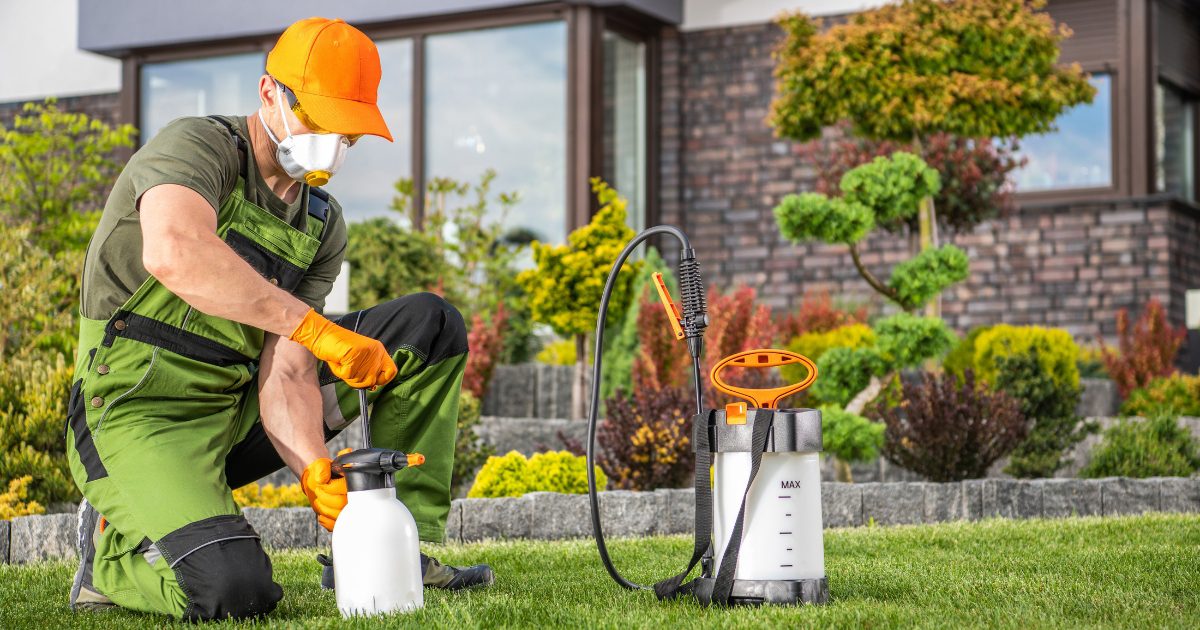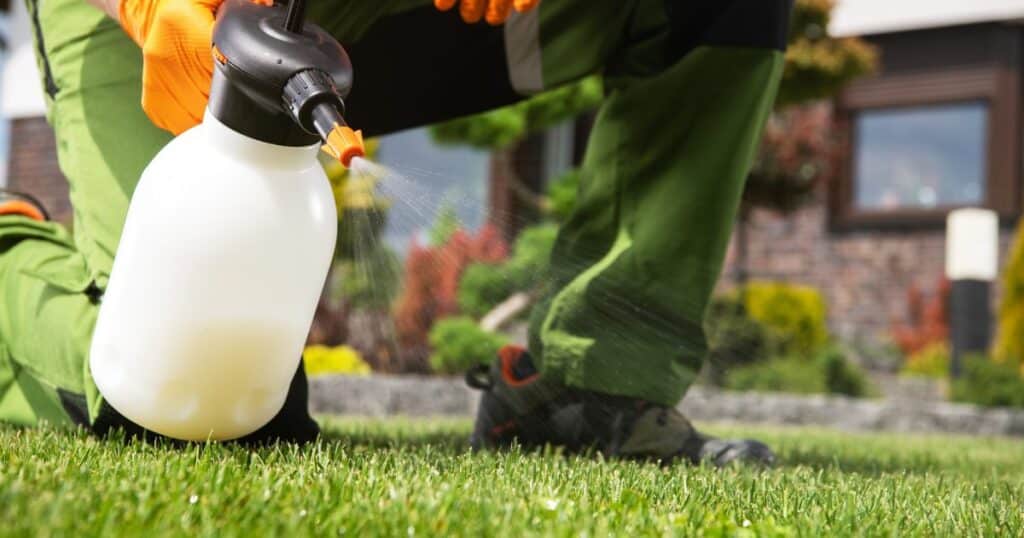
A well-maintained lawn is a point of pride for many homeowners. It creates a welcoming atmosphere, increases property value, and provides a space for outdoor activities.
However, achieving the perfect lawn requires ongoing care and maintenance. One essential aspect of lawn care is the use of chemicals to help keep the grass healthy and vibrant.
The Importance of Lawn Care and Maintenance
Lawn care involves more than just mowing the grass every few weeks. It also includes regular watering, fertilization, pest control, weed management, and disease prevention.
Neglecting any of these tasks can lead to an unhealthy lawn that is more susceptible to damage from pests or environmental stressors. A healthy lawn not only looks beautiful but also helps prevent soil erosion, filters pollutants from the air and water, and provides a habitat for wildlife.
RELATED: Green Your Lawn with All-Natural Lawn Care Services in Dallas
The Role of Dallas Lawn Care Chemicals
Chemicals play a vital role in maintaining a healthy lawn in Dallas’s climate conditions. Fertilizers provide essential nutrients such as nitrogen, phosphorus, and potassium to promote growth and development. Herbicides are used to eliminate weeds that compete with grass for resources like sunlight or nutrients.
Pesticides help control unwanted insects that can damage or kill grass plants, while fungicides prevent diseases such as brown patches or dollar spots. While chemicals are necessary tools in achieving a lush green lawn in Texas’s challenging climate conditions, using them incorrectly can cause significant environmental harm; therefore, it’s important only to use them as prescribed by professionals based on your unique yard characteristics.
Understanding Dallas Lawn Care Chemicals
Chemicals play a significant role in maintaining the health and appearance of lawns. There are different types of chemicals used in lawn care, including fertilizers, herbicides, pesticides, and fungicides. Each type of chemical has a particular function that contributes to maintaining the overall health of your lawn.
Fertilizers
Fertilizers are chemicals designed to provide essential nutrients that grass needs to grow properly. These nutrients include nitrogen, phosphorus, and potassium.
Nitrogen helps grass develop a healthy green color, while phosphorus promotes strong root growth. Potassium helps grass resist drought and disease and improves cold tolerance.
Applying fertilizers at the right time is crucial for their effectiveness. Springtime, when the grass begins its active growth period after winter dormancy, is an ideal time to apply fertilizer with a high nitrogen content, as this assists with leaf development and the building of carbohydrate reserves for summertime activities such as heat or drought stress.
Herbicides
Weeds can be highly detrimental to your lawn’s overall health because they compete with grass for the same water and nutrient resources. Herbicides help control weeds by killing or stopping their growth without harming surrounding vegetation like your lawn. Pre-emergent herbicides work by preventing weed seeds from germinating in the first place before they take root, while post-emergent herbicides kill existing weeds selectively or non-selectively based on their mode of action on particular weed species or life cycle stage.
Pesticides & Fungicides
Pesticides, as well as fungicides, help protect lawns from pests such as mosquitoes (carriers of dangerous diseases), grubs, and other insects that feast on plant foliage, while fungi attack plant roots causing wilting, yellowing, and eventually death. Like herbicides, pesticides, and fungicides can be applied either preventively or curatively.
Preventive applications focus on destroying pests before they emerge, while curative applications target those that have already established themselves in your lawn. While it is best to avoid applying pesticides or fungicides unless absolutely necessary, as some may have small amounts of toxicity when misused or overused. Therefore it is important to read the label carefully prior to use for safety concerns.
Understanding these chemicals helps you make the right choice for your lawn care needs. It is essential not only to choose the right product but also to administer them correctly in terms of application timing and controlled rates to maximize their effectiveness and minimize potential damage.
Choosing the Right Chemicals for Your Lawn
Factors to Consider When Selecting Chemicals
When selecting chemicals for your lawn, it is important to consider several factors to ensure that you are using the most appropriate product. Factors such as soil type, grass species, climate conditions, and pest problems should all be taken into account.
Soil type is an important factor in choosing the right fertilizer for your lawn. Different fertilizers are designed for specific soil types; some work better in sandy soils, while others are more effective in clay soils.
Additionally, some soils may lack certain nutrients that are essential for healthy lawn growth. Conducting a soil test can help determine which nutrients are missing from your soil and which fertilizer would best suit your lawn’s needs.
Grass species also play a crucial role in selecting the right chemical products. Different grasses have unique characteristics and requirements that affect how they respond to different chemicals.
For example, St. Augustine grass is more sensitive to weed killers than other varieties of grass, so it requires special attention when choosing herbicides. Climate conditions are another important consideration when selecting chemical products for your lawn care regimen.
The weather patterns in Dallas can vary greatly throughout the year; hot summers and cold winters can impact how chemicals work on your lawn. Certain products may be less effective during extreme weather conditions or may require more frequent applications.
Tips for Reading and Interpreting Product Labels
Once you have identified the factors specific to your lawn care needs, it is important to read product labels carefully before purchasing or applying any chemicals. These labels contain valuable information on how the product should be used safely and effectively.
One key piece of information found on most labels is the active ingredient(s) contained within the product. Understanding these ingredients can help you select a chemical that targets a specific pest or nutrient deficiency without harming other aspects of your lawn.
It is also important to follow the manufacturer’s instructions for proper application rates, timing, and safety precautions. Applying too much of a chemical product can damage your lawn or the environment while applying too little may not have the desired effect.
It is always a good idea to research product reviews and ratings before making a purchase. Other lawn care enthusiasts may have helpful insights on which products work best for different types of lawns.
Best Practices for Applying Dallas Lawn Care Chemicals
When it comes to applying lawn care chemicals, it’s important to follow the proper procedures to ensure they are used safely and effectively. Here are some best practices to keep in mind:
Step-by-step instructions on how to apply different types of chemicals safely and effectively
Fertilizers: Apply fertilizer evenly across the lawn using a spreader, making sure to avoid overlapping or missing areas. Water the lawn immediately after applying the fertilizer to help it absorb into the soil.
Herbicides and Pesticides: Apply these chemicals only when necessary and according to product instructions. Use a sprayer or spreader to apply evenly across affected areas, being careful not to apply too much. Avoid using it on windy days or when rain is expected within 24 hours.
Fungicides: Apply fungicide as soon as symptoms of the disease appear on the grass, following product instructions carefully. Use a sprayer or spreader for even application, and avoid watering the lawn for 24 hours after application.
Discussion on timing considerations such as weather conditions and seasonal growth patterns
The timing of chemical applications can greatly affect their effectiveness. Here are some tips:
- Weed control: apply herbicides during times of active weed growth, which is typically in late spring and early fall.
- Fertilization: apply fertilizers during periods of active growth, usually in spring and fall.
- Pest control: apply pesticides during times of peak activity for pests, which can vary depending on species and climate.
- Fungus control: apply fungicides at the first sign of disease symptoms, and reapply as necessary according to product instructions.
Additionally, be sure to check weather conditions before applying any chemicals. Avoid applying during extreme heat or cold or when rain is expected within 24 hours. Following these timing considerations can help ensure optimal results from your lawn care chemical applications.
Potential Risks Associated with Dallas Lawn Care Chemicals
Overview of potential risks associated with chemical use, such as environmental damage or health hazards
While Dallas lawn care chemicals can have a positive impact on the health and appearance of your lawn, they also carry certain risks that must be considered. For instance, excessive use of fertilizers and pesticides can lead to runoff that pollutes nearby water sources, causing harm to aquatic life and other organisms. Additionally, some chemicals may pose a health risk to humans and pets if not used properly.
One of the most significant environmental risks associated with Dallas lawn care chemicals is their role in contributing to the pollution of rivers, lakes, and groundwater sources. Excess chemicals can enter these water sources through surface runoff after heavy rain events or irrigation.
This pollution can disrupt natural habitats and cause declines in fish populations that rely on clean water for survival. In addition to environmental damage, certain chemical substances used in Dallas lawn care can pose serious health hazards to humans.
Tips for minimizing risks through proper handling, storage, disposal, and protective equipment
To minimize the risks associated with Dallas lawn care chemicals it’s important to take precautions when handling them. Protective gear such as gloves, goggles, long sleeves, and pants should be worn when mixing or applying chemicals.
It’s also important to store these products out of reach of children or pets since ingestion can cause serious harm. Proper disposal is another essential aspect of minimizing potential hazards associated with chemical use for your lawn care regimen.
Unused products should not be discarded down drains or sewers since this could result in contamination of public water supplies; instead, take them to a hazardous waste facility for eco-friendly disposal. In order to minimize the environmental impact of using Dallas lawn care chemicals, it’s essential that you follow instructions carefully by reading product labels before using them on your property.
This will ensure you apply the right amount and at the proper intervals. By following these guidelines, you can enjoy a lush and healthy lawn without putting your health or the environment at risk.
RELATED: Green and Lush: How Organic Lawn Care is Flourishing in Dallas
Frequently Asked Questions
What chemicals are in lawn fertilizer?
Lawn fertilizers can contain a variety of chemicals, including nitrogen, phosphorus, potassium, and micronutrients like iron and zinc. Some fertilizers may also contain pesticides or herbicides.
How often do you apply chemical fertilizer?
The frequency of chemical fertilizer application depends on the specific product and the needs of your lawn. In general, most chemical fertilizers recommend application every 6-8 weeks during the growing season.
How long do chemicals stay in the grass?
The duration that chemicals stay in grass depends on various factors such as the type of chemical, application method, soil conditions, and weather. Some chemicals may break down quickly, while others can persist in the soil and plant tissues for longer periods.
What chemical makes grass grow faster?
Nitrogen is the primary chemical that promotes grass growth, and it is typically found in most lawn fertilizers. However, excessive use of nitrogen can lead to environmental problems such as water pollution and harm to beneficial insects.
What is the best mix for lawn fertilizer?
The best mix for lawn fertilizer depends on the specific needs of your lawn and soil conditions. In general, most lawn fertilizers contain a blend of nitrogen, phosphorus, and potassium, with varying ratios depending on the stage of growth.
How can I fertilize my lawn without chemicals?
To fertilize your lawn without chemicals, you can use organic fertilizers such as compost or manure, or you can use natural soil amendments like bone meal or fish meal. Additionally, you can promote healthy soil by aerating, using mulch, and planting cover crops.
Conclusion
Throughout this article, we have covered the importance of using Dallas lawn care chemicals to maintain a healthy and vibrant lawn. We discussed the different types of chemicals available, including fertilizers, herbicides, pesticides, and fungicides.
We also highlighted factors to consider when selecting chemicals for your specific lawn, such as soil type, grass species, climate conditions, and pest problems. We provided tips on how to read and interpret product labels to ensure safe and effective use.
Additionally, we gave step-by-step instructions on how to apply different types of chemicals safely and effectively while discussing timing considerations like weather conditions and seasonal growth patterns. We explained potential risks associated with chemical use, such as environmental damage or health hazards.






